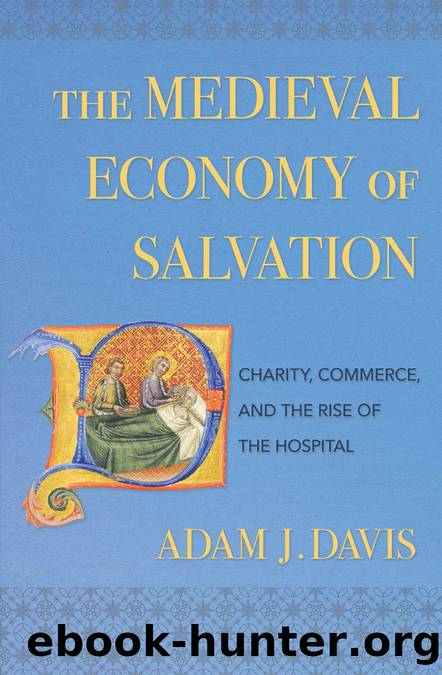The Medieval Economy of Salvation by Adam J. Davis;

Author:Adam J. Davis;
Language: eng
Format: epub
Publisher: Lightning Source Inc. (Tier 3)
Published: 2019-08-28T00:00:00+00:00
* * *
1. Little, Religious Poverty; Le Goff, Money and the Middle Ages.
2. Chiffoleau, Comptabilité de lâau-delà ; Joel Rosenthal, The Purchase of Paradise: Gift Giving and the Aristocracy, 1307â1485 (London: Routledge, 1972); Richard L. Keyser, âLa transformation de lâéchange des dons pieux: Montier-la-Celle, Champagne, 1100â1350,â Revue historique 305, no. 4 (2003): 793â816; Richard L. Keyser, âGift, Dispute, and Contract: Gift Exchange and Legalism in Monastic Property Dealings, Montier-la-Celle, France, 1100â1350,â (PhD dissertation, Johns Hopkins University, 2001).
3. On the earlier model of associative gift exchange, see Megan McLaughlin, Consorting with the Saints: Prayer for the Dead in Early Medieval France (Ithaca: Cornell University Press, 1994).
4. Georges Duby, Lâéconomie rurale et la vie des campagnes dans lâOccident médiéval (France, Angle-terre, Empire, IXeâXVe siècles). Essai de synthèse et perspectives de recherches (Paris: Aubier, 1962); Little, Religious Poverty; Bijsterveld, âMedieval Gift.â
5. Martha C. Howell, Commerce before Capitalism in Europe, 1300â1600 (Cambridge: Cambridge University Press, 2010), 47.
6. Chiffoleau, La comptabilité de lâau-delà ; Howell, Commerce Before Capitalism, 190.
7. Brown, Ransom of the Soul, 98; Anderson, Charity.
8. Brown, Ransom of the Soul, 98.
9. Jacques Le Goff, âTemps de lâÃglise et temps du marchand,â Annales 15, no. 3 (May-June 1960): 417â33.
10. Florian Mazel, âAmitié et rupture de lâamitié: Moines et grands laïcs provençaux au temps de la crise grégorienne (milieu XIeâmilieu XII siècle),â Revue historique 633, no. 1 (2005): 53â95.
11. On the steep decline in the number of pious gifts to monasteries in Burgundy and Champagne during the later thirteenth and fourteenth centuries, see Keyser, âGift, Dispute, and Contract,â 162â69; Jeannine Cossé-Durlin, ed., Cartulaire de Saint-Nicaise de Reims (Paris: CNRS, 1991), 114; Robert Fossier, âLa puissance économique de lâabbaye de Clairvaux au XIIIe siècle,â in Histoire de Clairvaux, Actes du Colloque 1990 (Bar-sur-Aube, France: Association Renaissance de lâabbaye de Clairvaux, 1991): 73â83. Jochen Schenk has also observed a decline in donations to the Templars in Provins in the second half of the thirteenth century. See Schenk, Templar Families, 39â41.
12. Cossé-Durlin, ed., Cartulaire de Saint-Nicaise de Reims, 114.
13. Cossé-Durlin, ed., Cartulaire de Saint-Nicaise de Reims, 114.
14. Keyser, âGift, Dispute, and Contract,â 169; Fossier, âPuissance économique.â
15. Keyser, âGift, Dispute, and Contract,â 60, 160â64. Touati found that testamentary bequests to the leprosaries in the province of Sens also peaked during the second half of the thirteenth century. See Touati, Maladie et société, 503.
16. The hôtel-Dieu-le-Comte in Troyes differed from these two hospitals in that its donations did not increase during the latter half of the thirteenth century, but they did not decrease either.
17. Rawcliffe, Hospitals of Medieval Norwich, 158.
18. Pierre Desportes, ed., Testaments Saint-Quentinois du XIVe siècle (Paris: CNRS Editions, 2003), xxxiii. The âcarcerariiâ could refer to those who were bedridden or otherwise unable to work, but the term could also refer to parish poor relief funds or administrators. See Gaston Robert, âLes char-treries paroissiales et lâassistance publique à Reims jusquâen 1633,â Travaux de lâAcadémie nationale de Reims 141 (1926â27), 166â68.
19. Desportes, ed., Testaments, 124â27.
20. Gaston Robert, âLes beguines de Reims et la maison de Saint-Agnès,â Travaux de lâAcadémie nationale de Reims 137 (1922â1923), 261â66.
Download
This site does not store any files on its server. We only index and link to content provided by other sites. Please contact the content providers to delete copyright contents if any and email us, we'll remove relevant links or contents immediately.
Joan of Arc by Mary Gordon(3784)
Victory over the Darkness by Neil T. Anderson(2731)
The Gnostic Gospels by Pagels Elaine(2393)
Devil, The by Almond Philip C(2204)
The Nativity by Geza Vermes(2113)
The Psychedelic Gospels: The Secret History of Hallucinogens in Christianity by Jerry B. Brown(2072)
Going Clear: Scientology, Hollywood, and the Prison of Belief by Lawrence Wright(1881)
Going Clear by Lawrence Wright(1868)
A TIME TO KEEP SILENCE by Patrick Leigh Fermor(1771)
Barking to the Choir by Gregory Boyle(1726)
Old Testament History by John H. Sailhamer(1712)
Augustine: Conversions to Confessions by Robin Lane Fox(1686)
A History of the Franks by Gregory of Tours(1636)
The Bible Doesn't Say That by Dr. Joel M. Hoffman(1608)
A Prophet with Honor by William C. Martin(1602)
The Knights Templar by Sean Martin(1597)
by Christianity & Islam(1561)
The Amish by Steven M. Nolt(1488)
The Source by James A. Michener(1455)
